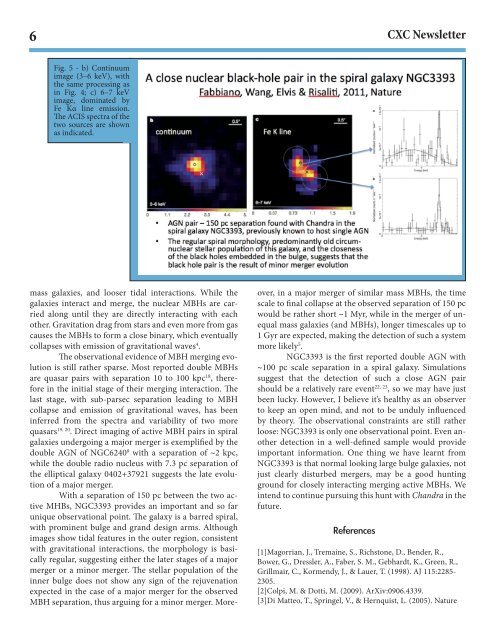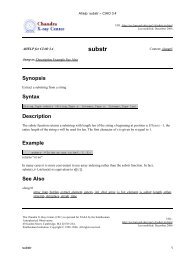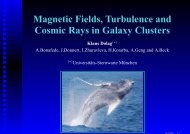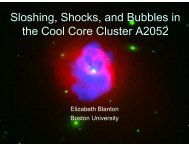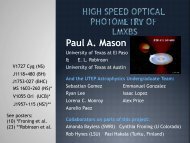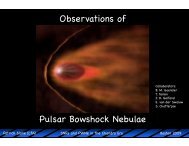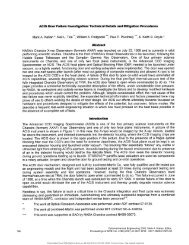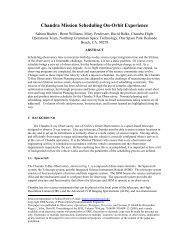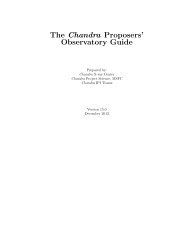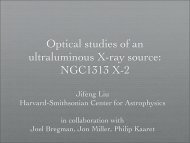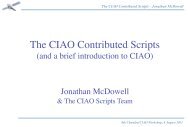PDF Version - Chandra X-Ray Observatory (CXC)
PDF Version - Chandra X-Ray Observatory (CXC)
PDF Version - Chandra X-Ray Observatory (CXC)
You also want an ePaper? Increase the reach of your titles
YUMPU automatically turns print PDFs into web optimized ePapers that Google loves.
6<br />
Fig. 5 - b) Continuum<br />
image (3–6 keV), with<br />
the same processing as<br />
in Fig. 4; c) 6–7 keV<br />
image, dominated by<br />
Fe Kα line emission.<br />
The ACIS spectra of the<br />
two sources are shown<br />
as indicated.<br />
mass galaxies, and looser tidal interactions. While the<br />
galaxies interact and merge, the nuclear MBHs are carried<br />
along until they are directly interacting with each<br />
other. Gravitation drag from stars and even more from gas<br />
causes the MBHs to form a close binary, which eventually<br />
collapses with emission of gravitational waves 4 .<br />
The observational evidence of MBH merging evolution<br />
is still rather sparse. Most reported double MBHs<br />
are quasar pairs with separation 10 to 100 kpc 18 , therefore<br />
in the initial stage of their merging interaction. The<br />
last stage, with sub-parsec separation leading to MBH<br />
collapse and emission of gravitational waves, has been<br />
inferred from the spectra and variability of two more<br />
quasars 19, 20 . Direct imaging of active MBH pairs in spiral<br />
galaxies undergoing a major merger is exemplified by the<br />
double AGN of NGC6240 8 with a separation of ~2 kpc,<br />
while the double radio nucleus with 7.3 pc separation of<br />
the elliptical galaxy 0402+37921 suggests the late evolution<br />
of a major merger.<br />
With a separation of 150 pc between the two active<br />
MHBs, NGC3393 provides an important and so far<br />
unique observational point. The galaxy is a barred spiral,<br />
with prominent bulge and grand design arms. Although<br />
images show tidal features in the outer region, consistent<br />
with gravitational interactions, the morphology is basically<br />
regular, suggesting either the later stages of a major<br />
merger or a minor merger. The stellar population of the<br />
inner bulge does not show any sign of the rejuvenation<br />
expected in the case of a major merger for the observed<br />
MBH separation, thus arguing for a minor merger. More-<br />
<strong>CXC</strong> Newsletter<br />
over, in a major merger of similar mass MBHs, the time<br />
scale to final collapse at the observed separation of 150 pc<br />
would be rather short ~1 Myr, while in the merger of unequal<br />
mass galaxies (and MBHs), longer timescales up to<br />
1 Gyr are expected, making the detection of such a system<br />
more likely 5 .<br />
NGC3393 is the first reported double AGN with<br />
~100 pc scale separation in a spiral galaxy. Simulations<br />
suggest that the detection of such a close AGN pair<br />
should be a relatively rare event 22, 23 , so we may have just<br />
been lucky. However, I believe it’s healthy as an observer<br />
to keep an open mind, and not to be unduly influenced<br />
by theory. The observational constraints are still rather<br />
loose: NGC3393 is only one observational point. Even another<br />
detection in a well-defined sample would provide<br />
important information. One thing we have learnt from<br />
NGC3393 is that normal looking large bulge galaxies, not<br />
just clearly disturbed mergers, may be a good hunting<br />
ground for closely interacting merging active MBHs. We<br />
intend to continue pursuing this hunt with <strong>Chandra</strong> in the<br />
future.<br />
References<br />
[1]Magorrian, J., Tremaine, S., Richstone, D., Bender, R.,<br />
Bower, G., Dressler, A., Faber, S. M., Gebhardt, K., Green, R.,<br />
Grillmair, C., Kormendy, J., & Lauer, T. (1998). AJ 115:2285-<br />
2305.<br />
[2]Colpi, M. & Dotti, M. (2009). ArXiv:0906.4339.<br />
[3]Di Matteo, T., Springel, V., & Hernquist, L. (2005). Nature


